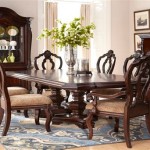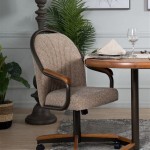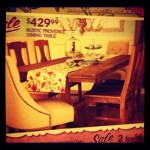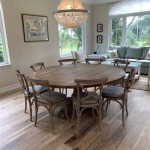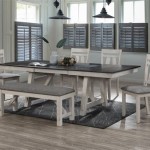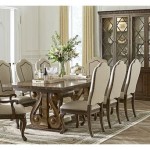Top Rated Dining Room Tables: A Comprehensive Guide
The dining room table serves as the focal point of the dining area, facilitating meals, conversations, and gatherings. Selecting a dining room table requires careful consideration of various factors, including size, shape, material, style, and budget. This article provides an overview of top-rated dining room tables, examining their attributes and suitability for diverse needs and preferences.
Size and Shape Considerations
Determining the appropriate size and shape of a dining room table is crucial to ensure functionality and comfort. The size should be proportional to the dimensions of the dining room, allowing ample space for seating and movement. A general guideline is to allocate at least three feet of space between the table and the walls or other furniture. Consider the number of people typically accommodated at the table. For smaller spaces or households, a round or oval table may offer a more intimate and space-efficient solution.
Rectangular tables are a popular choice for larger dining rooms, providing ample surface area for serving dishes and seating multiple guests. They are particularly well-suited for hosting formal dinners or larger family gatherings. Square tables offer a balanced aesthetic and can be a good option for smaller square-shaped dining rooms. Extension tables offer versatility, allowing the table to be expanded or reduced in size to accommodate varying numbers of diners. These tables are beneficial for those who frequently entertain guests but also desire a smaller table for everyday use.
The shape of the table also influences the flow of conversation and interaction among diners. Round tables promote a sense of equality and encourage conversation among all seated. Rectangular tables, on the other hand, may create a more formal atmosphere with a clear head of the table. Square tables often foster a sense of intimacy and are well-suited for smaller groups.
Material Choices and Durability
The material from which a dining room table is constructed significantly affects its durability, appearance, and maintenance requirements. Common materials include wood, glass, metal, and stone. Each material offers distinct advantages and disadvantages, depending on lifestyle and aesthetic preferences.
Wood is a classic and versatile choice for dining room tables. It offers a warm and inviting aesthetic and can be easily customized to fit a variety of styles. Solid wood tables are known for their durability and longevity, but they can also be more expensive. Common wood types include oak, maple, cherry, and walnut. Each wood has unique grain patterns and color variations. Veneered wood tables consist of a thin layer of real wood adhered to a less expensive core material. These tables offer a more affordable option while still providing the look and feel of real wood. Selecting a wood finish can impact the protection and overall look of the table. Durable finishes, such as polyurethane, offer resistance to scratches and stains.
Glass tables offer a sleek and modern aesthetic. They can make a small dining room appear larger and brighter by reflecting light. Tempered glass is a popular choice for dining room tables due to its strength and safety. If broken, tempered glass shatters into small, blunt pieces, reducing the risk of injury. Glass tables require regular cleaning to remove fingerprints and smudges. Metal tables are known for their durability and industrial aesthetic. They are often constructed from steel, iron, or aluminum. Metal tables can be paired with wood or glass tabletops to create a more unique and visually appealing design. Stone tables, such as those made of marble or granite, offer a luxurious and sophisticated look. They are highly durable and resistant to scratches and heat. However, stone tables can be heavy and expensive.
The choice of material should also consider the overall design aesthetic of the dining room. A rustic farmhouse style may call for a solid wood table with a distressed finish, while a modern minimalist style may benefit from a glass or metal table. Consider the presence of children or pets within the household. Choosing a material that is resistant to scratches, stains, and spills will help ensure the longevity and appearance of the dining room table.
Style and Design Considerations
The style and design of a dining room table should complement the overall aesthetic of the dining room and reflect personal preferences. Dining room tables are available in a wide range of styles, from traditional to contemporary, rustic to modern. Coordinating the table with other furniture in the room, such as chairs, sideboards, and lighting fixtures, creates a cohesive and visually appealing space.
Traditional dining room tables often feature ornate details, such as carved legs, molded edges, and rich wood finishes. These tables evoke a sense of formality and elegance. Contemporary dining room tables embrace clean lines, minimalist designs, and modern materials, such as glass and metal. They offer a sleek and sophisticated aesthetic that is well-suited for modern homes. Rustic dining room tables feature natural materials, such as reclaimed wood and exposed metal, creating a warm and inviting atmosphere. These tables often have a distressed finish, adding to their rustic charm. Mid-century modern dining room tables combine clean lines with organic shapes and warm wood tones. They are inspired by the design aesthetic of the mid-20th century and offer a timeless and stylish look.
The base of the dining room table also contributes to its overall style and design. Common base styles include four legs, trestle legs, pedestal bases, and hairpin legs. Four-legged tables are a classic and versatile choice that can be adapted to a variety of styles. Trestle legs provide stability and a rustic aesthetic. Pedestal bases offer a clean and modern look, freeing up legroom for diners. Hairpin legs are a popular choice for mid-century modern and industrial style tables. Consider the color and finish of the dining room table. Lighter wood tones can create a bright and airy feel, while darker wood tones can add warmth and richness. Painted finishes offer a wide range of color options to complement the dining room decor. Upholstered dining chairs can add comfort and style to the dining area. Consider the fabric, color, and design of the chairs to complement the dining room table and overall aesthetic.
When selecting a dining room table, it is essential to consider the overall style and design of the dining room. The table should complement the existing furniture and decor, creating a cohesive and visually appealing space. Personal preferences should also be taken into account when choosing a style that reflects individual tastes and lifestyle.
Budget and Value
The budget allocated for a dining room table plays a significant role in determining the available options. Dining room tables are available at a wide range of price points, from budget-friendly options to high-end designer pieces. Establishing a budget before beginning the shopping process helps narrow down the search and prevents overspending. Consider the long-term value of the dining room table. Investing in a high-quality table made from durable materials may be more cost-effective in the long run compared to purchasing a cheaper table that may need to be replaced sooner. Research different brands and retailers to compare prices and find the best deals. Online retailers often offer competitive prices and a wider selection compared to brick-and-mortar stores.
Consider the material and craftsmanship of the table. Solid wood tables are generally more expensive than veneered wood or MDF tables. Tables with intricate details and handcrafted elements may also command a higher price. Be aware of sales and promotions. Many retailers offer discounts on dining room tables during holidays and seasonal sales. Consider purchasing a used or refurbished dining room table. This can be a more affordable option, especially for solid wood or high-end tables. Inspect the table carefully for any damages or imperfections before making a purchase. Factor in the cost of delivery and assembly. Some retailers offer free delivery and assembly services, while others may charge an additional fee.
When assessing the value of a dining room table, consider its durability, style, and functionality. A well-constructed table that meets the needs of the household and complements the dining room decor is a worthwhile investment. Balance budget with quality and consider the long-term value of the dining room table.
Maintenance and Care
Proper maintenance and care are essential to prolong the life and preserve the appearance of a dining room table. Different materials require different cleaning methods and preventative measures. Implementing a consistent cleaning routine and taking precautions to protect the table from damage will help maintain its beauty for years to come.
Dust the dining room table regularly with a soft cloth to remove dirt and debris. Use a damp cloth to wipe the table surface, but avoid using excessive water. Dry the table immediately after wiping it down to prevent water spots or staining. For wood tables, use a wood cleaner or polish specifically designed for furniture. Follow the manufacturer's instructions carefully. Avoid using harsh chemicals or abrasive cleaners, as they can damage the finish. For glass tables, use a glass cleaner to remove fingerprints and smudges. Polish the glass with a soft cloth for a streak-free shine. Protect the table from heat and moisture. Use coasters and placemats to prevent rings and stains from hot or cold beverages. Use trivets to protect the table surface from hot dishes.
Protect the table from scratches and dents. Use tablecloths or table pads to provide a protective barrier against sharp objects. Avoid placing heavy objects directly on the table surface. Clean spills immediately to prevent staining. Blot the spill with a clean cloth and follow up with a appropriate cleaning solution for the material. Avoid using paper towels or abrasive cleaners, as they can scratch the surface. Periodically inspect the table for any signs of damage, such as scratches, dents, or loose joints. Repair any damage promptly to prevent it from worsening. Consider using a furniture repair kit to address minor scratches or dents. For more significant damage, consult a professional furniture repair service.
By following these maintenance and care tips, the dining room table can be preserved and enjoyed for many years. Consistent cleaning, preventative measures, and prompt repairs are essential to maintaining its beauty and functionality.

4 Questions To Help You Choose The Best Dining Room Table Home

10 Best Places To Buy Dining Tables In 2024

8 Best Kitchen And Dining Room Tables Of 2025 Tested By Editors

10 Best Places To Buy Dining Tables In 2024

Qualler 6 Piece Wood Top Espresso Dining Table Set With 4 Chairs Dtm000061p

8 Best Kitchen And Dining Room Tables Of 2025 Tested By Editors

Best Large Dining Room Tables 2024 Hgtv

Dovetail Judy Round Dining Table

Dining Room Top 20 Luxury Tables And Chairs Milan Design Agenda

Furniture Of America Jasmin Glass Top Round Dining Table With Black Base Parks Home Furnishings



